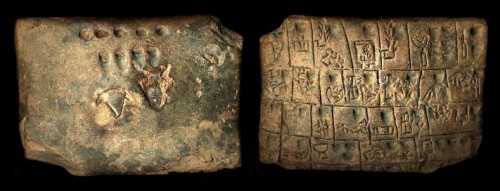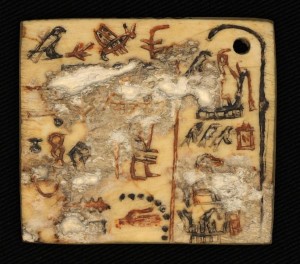Scribal and artistic spaces: micro- and macro-scale analyses
Topoi fellow Kathryn Piquette examined some of the world’s first writing (c.3100-c.2500 BCE), including proto-cuneiform from southern Mesopotamia (modern Iraq) and Egyptian hieroglyphic and hieratic from the lower Nile Valley, as well as contemporary artistic evidence from both regions.

Clay tablet inscribed using the proto-cuneiform script. Uruk IV (c.3350-3200 BCE | Photo: Museum of the Ancient Near East (VAM / Staatliche Museen zu Berlin) and CDLI
Previous research on this material often prioritises semiotic and other symbolic meanings as well as institutional-level explanations which focus on the economic, political and ideological requirements of an increasingly centralised administration. Kathryn’s research takes a different yet complementary bottom-up approach, emphasising micro-scale evidence for imagery as part of material practice.
During several museum research visits and field work, Kathryn documented 100 objects including portable artefacts such as cylinder seals, impressed sealings, cuneiform tablets, labels, as well as fixed image-bearing surfaces from stelae and tomb relief to rock art.

Kathryn undertaking Highlight Reflectance Transformation Imaging (H-RTI) of inscribed artefacts in the Egyptian Museum and Papyrus Collection / Staatliche Museen zu Berlin. Photograph courtesy Hembo Pagi

Ivory funerary label inscribed with early Egyptian hieroglyphs. 1st Dynasty (c.2900BCE) | Photo: Kathryn Piquette courtesy Trustees of the British Museum.
An innovative and essential element of Kathryn’s focus on the material practice of early scribes is the use of the advanced digital technology Reflectance Transformation Imaging (RTI). RTI is a computational photographic method that captures a subject’s surface shape and colour and enables the interactive re-lighting of the surface from any direction.
RTI also permits the mathematical enhancement of the artefact’s surface morphology and colour attributes. The enhancement functions of RTI reveal surface information that may not always be visible during first-hand examination.
Through an analysis of physical and technical features, her research aims to investigate the relationships between material type, methods and techniques of inscription/surface elaboration, possible tool choice, features of image composition and appearance — as well as to consider their possible impact on subsequent acts of perception and use. Archaeological data associated with these graphical spaces, including broader spatial and temporal information will also be compared and contrasted to understand how material choice impacted on form, function and meaning.
By charting similarities and differences between the evidence from early Egypt and southern Mesopotamia, the research aims to elucidate the relationship between the material visualisation of cultural knowledge at local and regional levels, and larger-scale processes of “state emergence’.
is Lecturer and Senior Research Consultant in Specialist Imaging with the UCL Centre for Digital Humanities’ Advanced Imaging Consultants (UCLAiC). From 2011 to 2013 she was COFUND research fellowship(funded by the Marie Curie Action COFUND) in affiliation with the Dahlem Research School, Topoi and the Institute of Ancient Near Eastern Languages and Civilizations with a research project on “A Comparative Study of Scribal and Artistic Spaces in Early Egypt and the Ancient Near East: Integrating micro- and macro-scale analyses”
Related Links
Feature: The Present uncovers the Past
Research project: (Z-COFOUND-1) A Comparative Study of Scribal and Artistic Spaces in Early Egypt and the Ancient Near East: Integrating micro- and macro-scale analyses
Read more articles in TOPOI FEATURE
